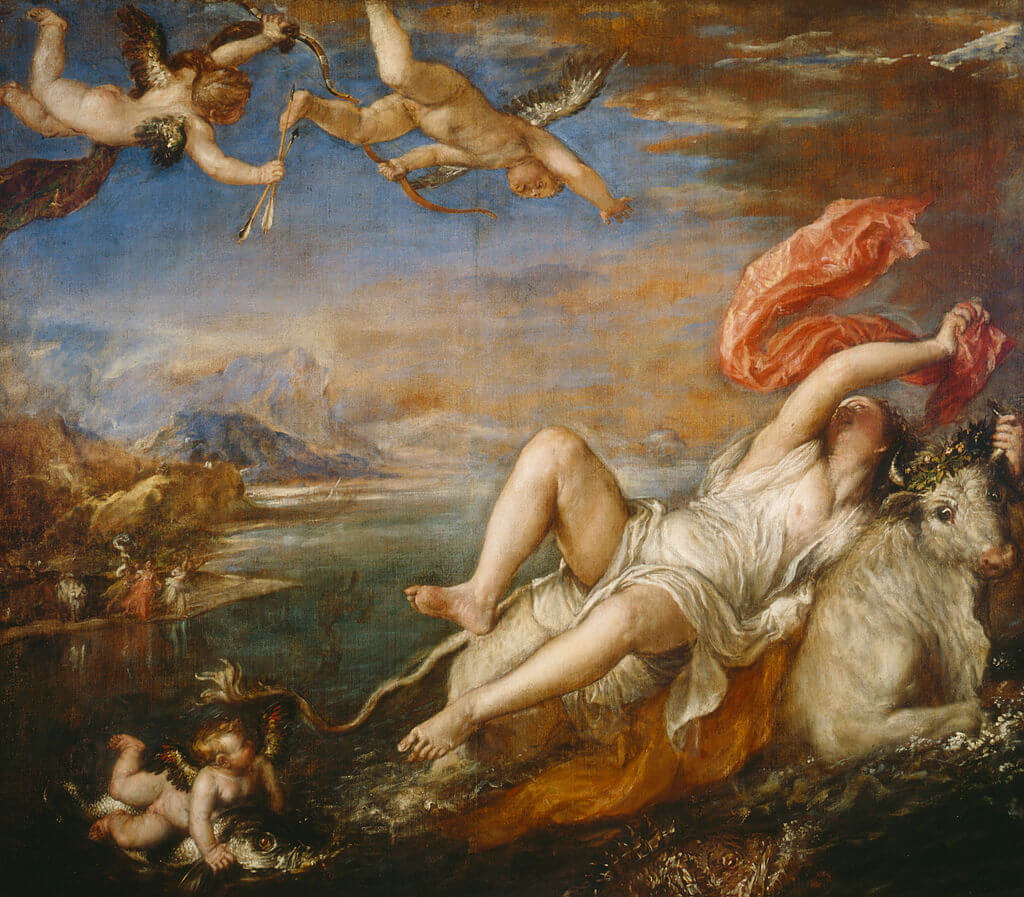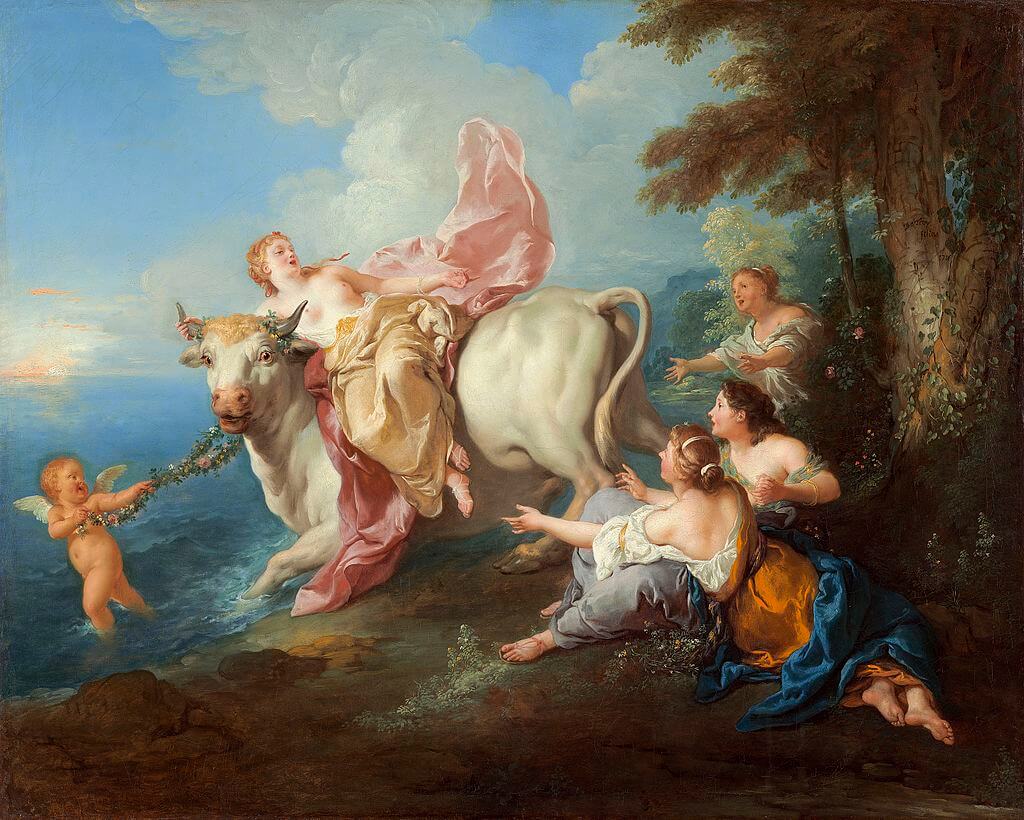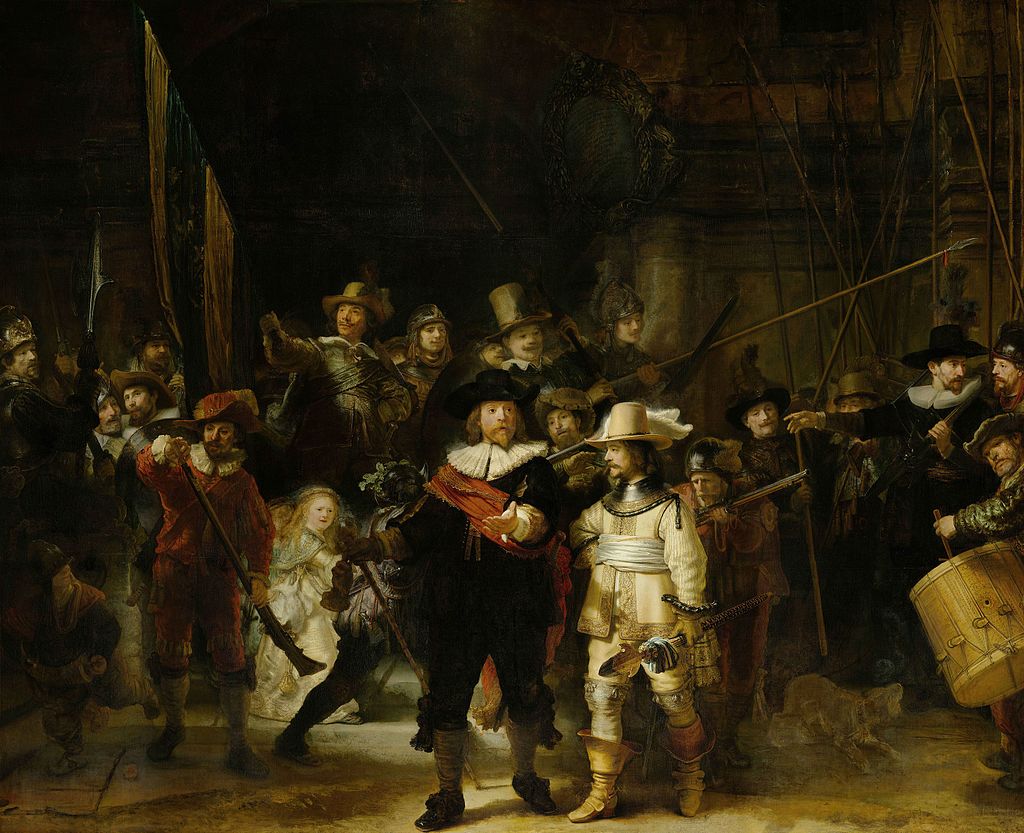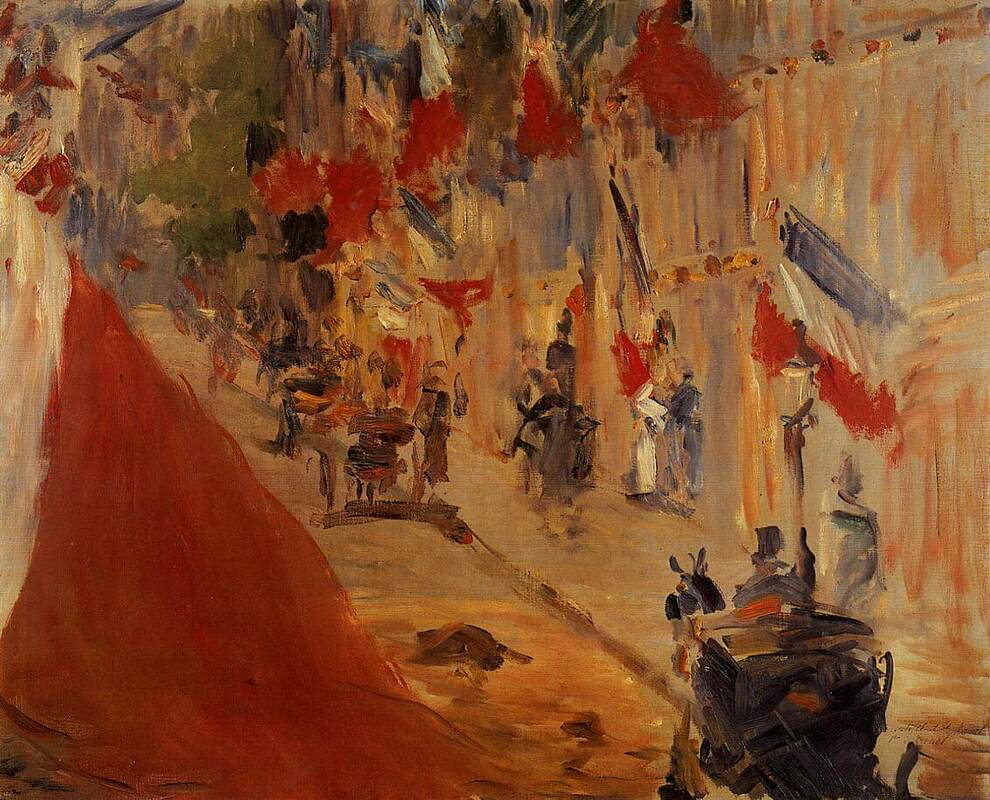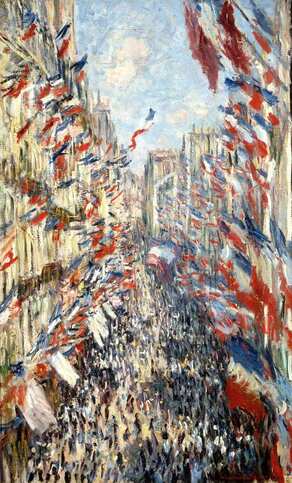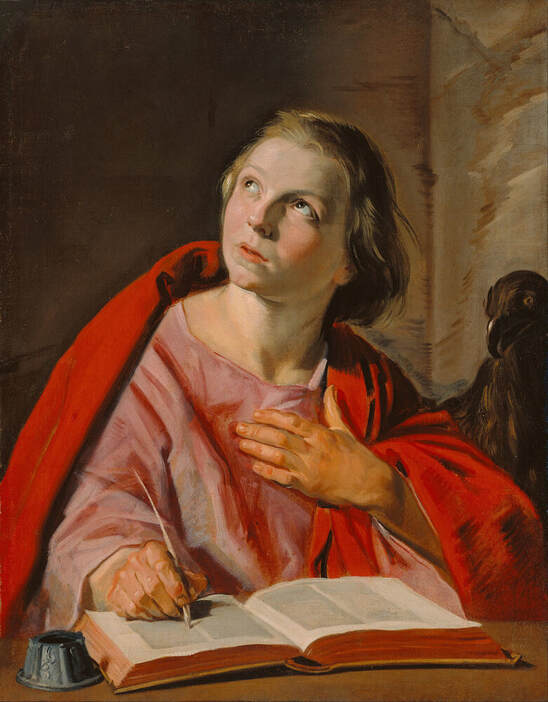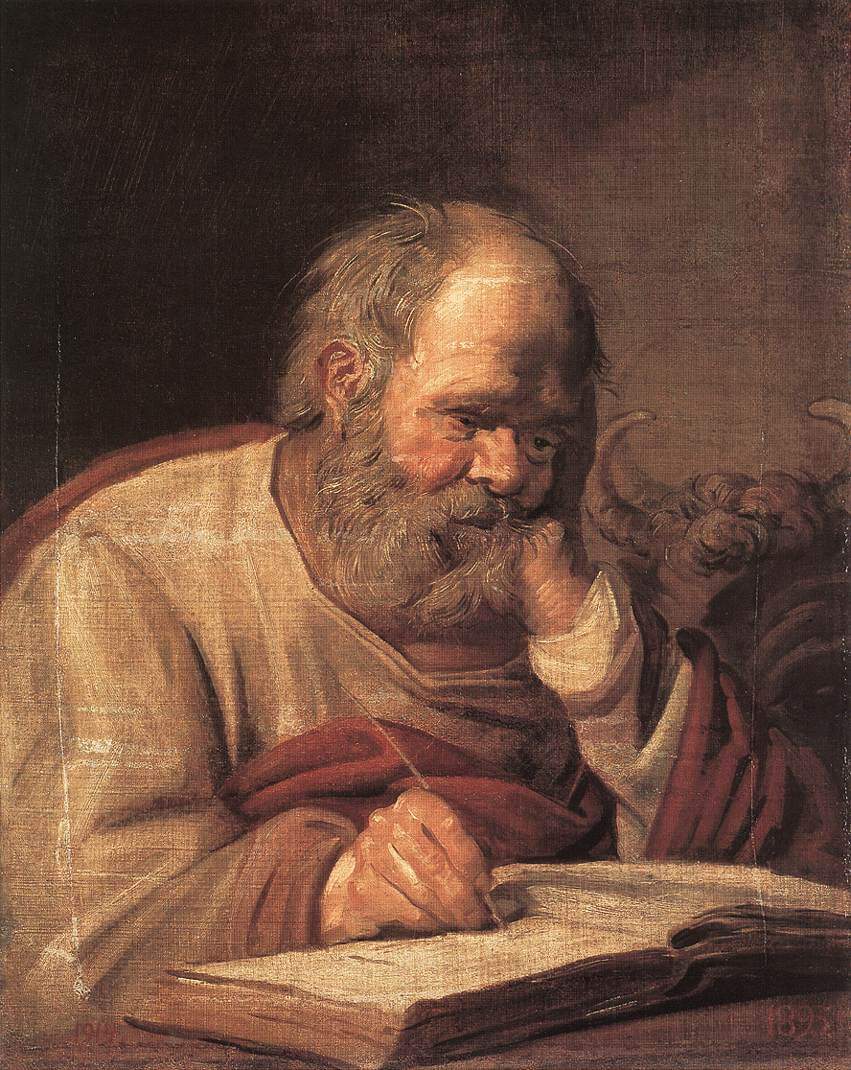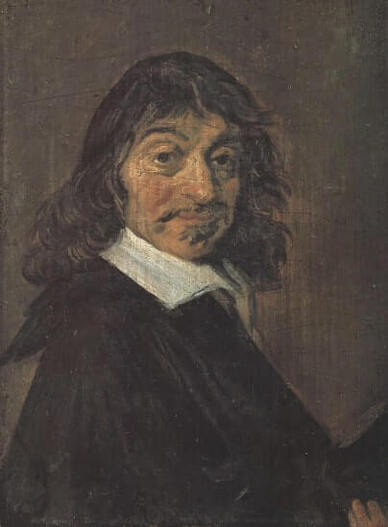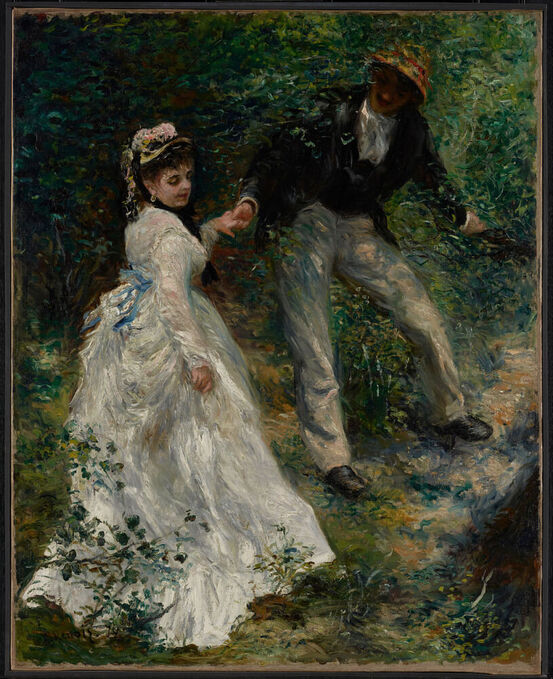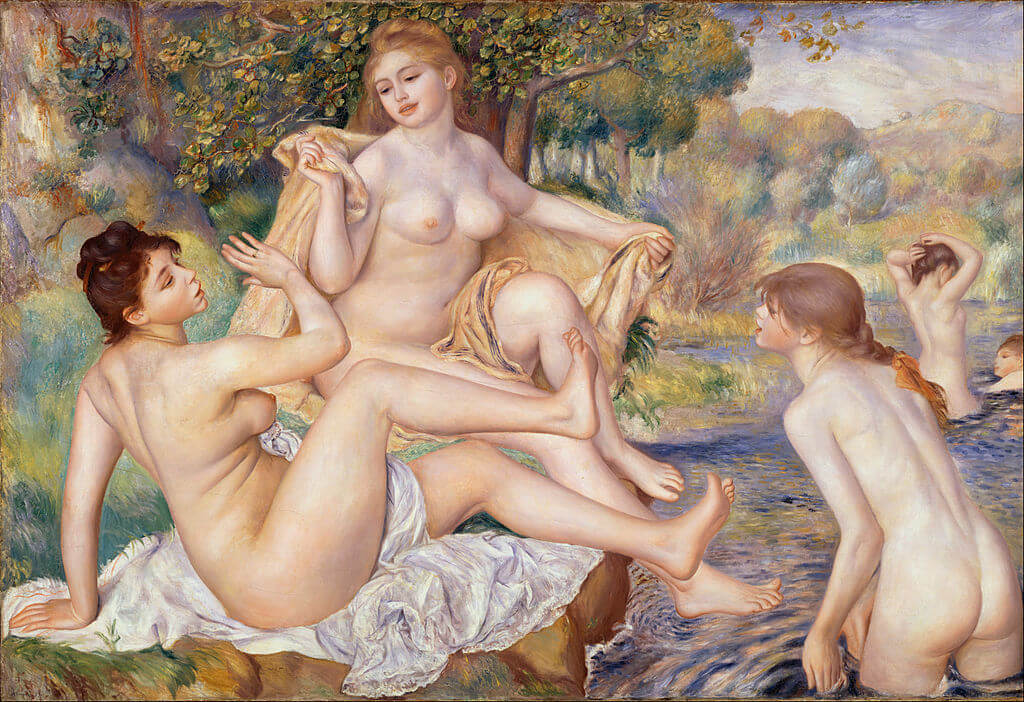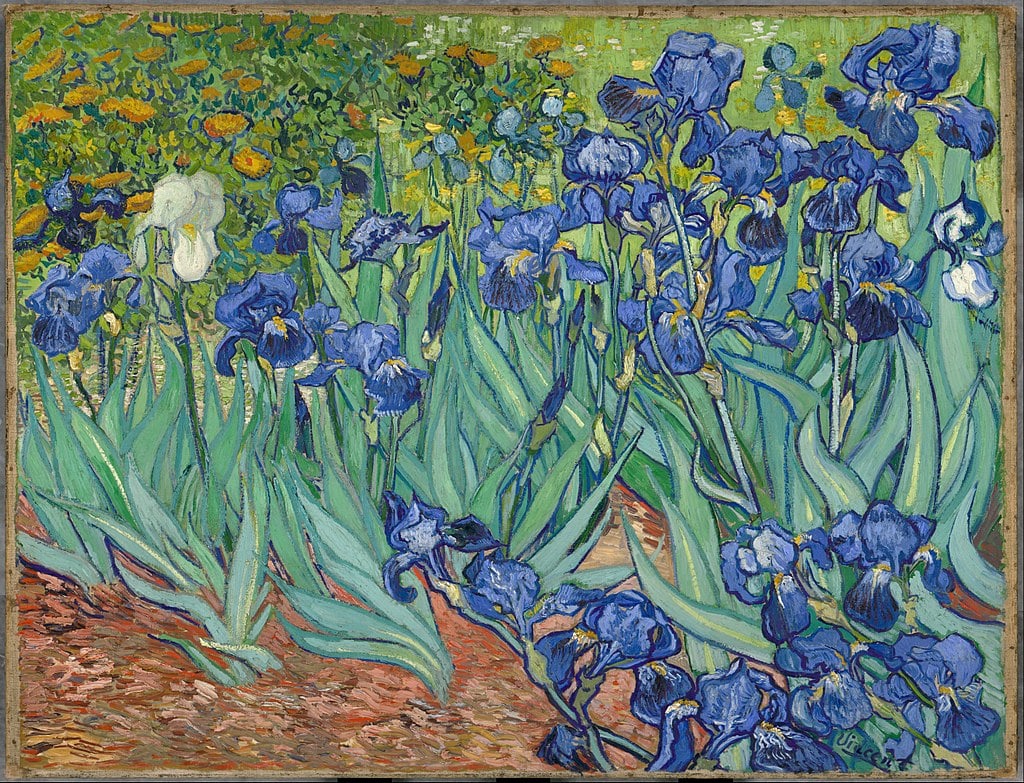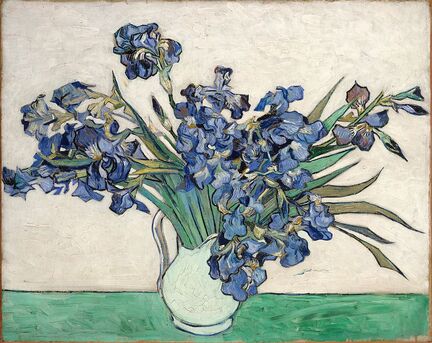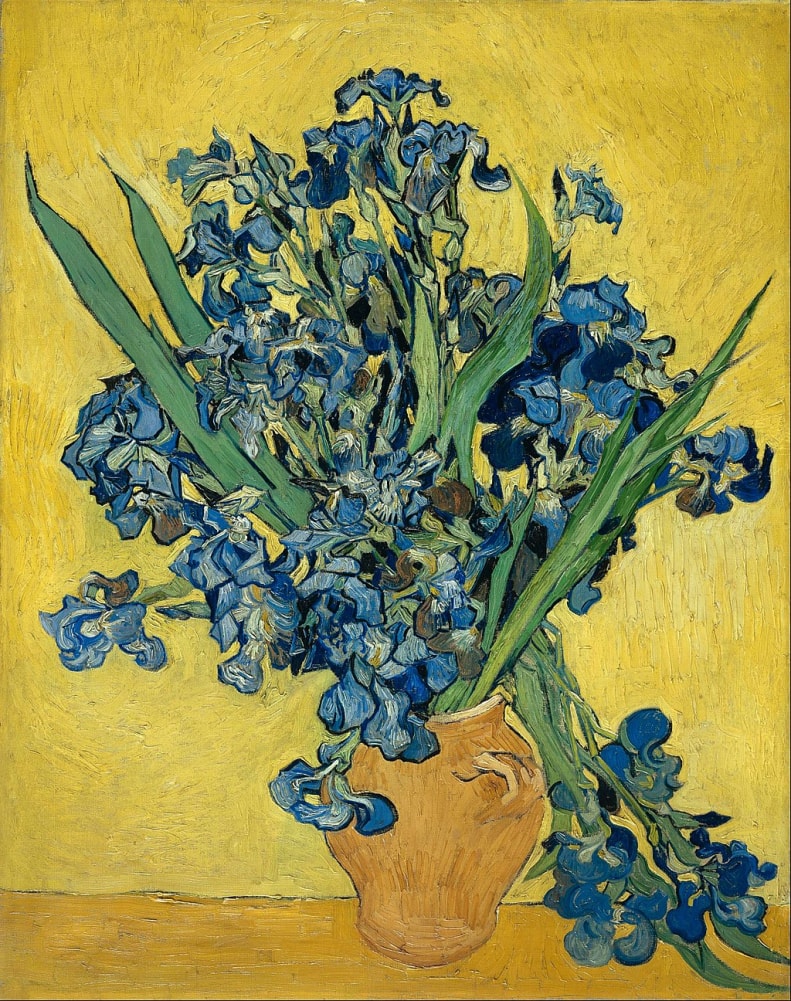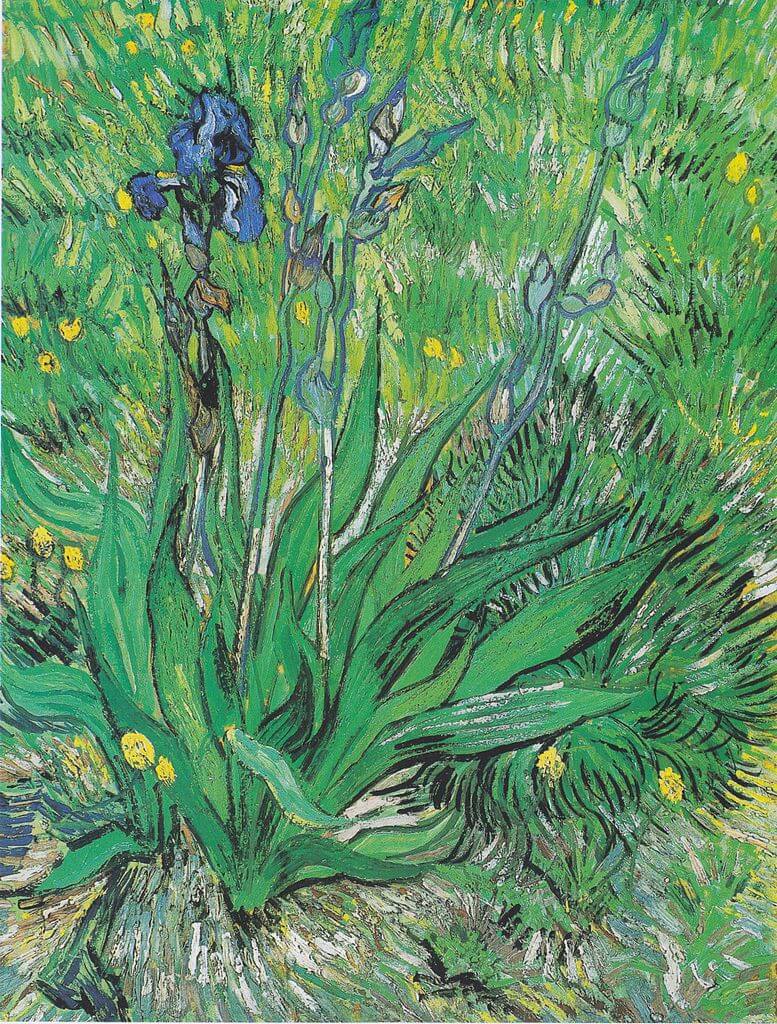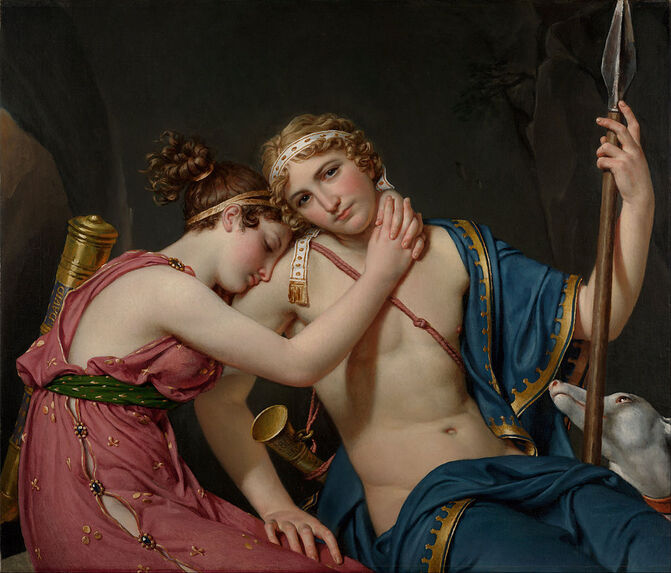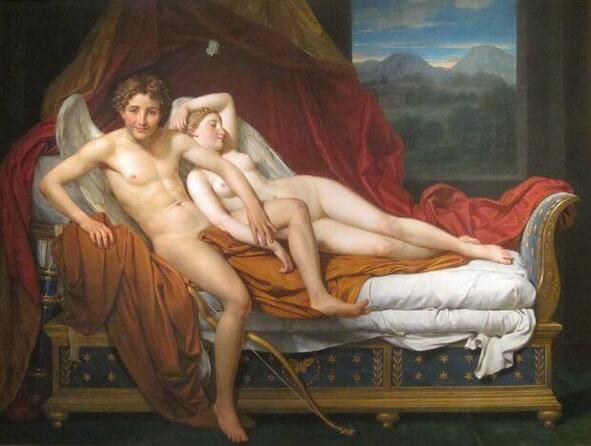|
Where? Room E204 of the J. Paul Getty Museum
When? 1632 What do you see? The Ancient Roman god Jupiter (Zeus in Greek mythology) is disguised as a beautiful white bull. He just seduced Europa and takes her away on his back into the sea. He has his tail up as an indication that he is happy with the successful abduction. Europa sits on top of the bull, holding a horn with her right hand, and fearfully looks back at her servants on the shore. They are the Virgins of Tyre (where Europa lived as well), with whom Europa was playing before she got abducted. They watch in disbelief how Europa gets abducted. The woman in blue has dropped the flower garland they made for the bull in her lap and raises her hands up in the air. The other woman looks at Europa while folding her hands as if she resigns in Europa’s fate. In the background is the horse carriage with four horses that had brought Europa to the beach. The story of Jupiter and Europa? This story is based on the second book of Metamorphoses by the Roman poet Ovid (Amazon link to Metamorphoses). At the end of the second book, in lines 833 till 875, Ovid describes how Jupiter falls in love with Europa. She was the daughter of a king in an Eastern land. Jupiter asks his son Mercury to go to that land and drive the herd of royal kettle to the beach, where Europa is playing with her servants. Jupiter disguises himself as a tame white bull and puts himself among the royal kettle. Europa recognizes his beauty and starts to play with him. While a bit afraid at first, she eventually climbs on his back, and Jupiter takes that opportunity to walk into the water and escape with her on his back. This story has also inspired other painters. Titian painted The Rape of Europa in the Isabella Stewart Gardner Museum in Boston, and Jean-François de Troy painted The Abduction of Europa in the National Gallery of Art in Washington, DC.
Background: This painting is one of only few paintings by Rembrandt in which he included an extensive landscape. The Getty Museum acquired it in 1995 for about $27 million, which was a new record for a Rembrandt painting at that time. They bought it together with another painting by Rembrandt, Daniel and Cyrus before the Idol Bel, which is also still in the Getty Museum.
Who is Europa? A figure in Greek mythology. She was born as the daughter of a king of a land somewhere near current-day Lebanon. She is primarily known by the story on her abduction by Jupiter who brought her to Crete. She was still a virgin before the got abducted.
Jupiter and Europa get three children together: Minos (who will become the king of Crete), Rhadamanthus, and Sarpedon. After their death, these three sons became the judges of the Underworld. The continent of Europe is named after Europa, as Jupiter took her from Asia to this new continent. Also, one of the moons of the planet Jupiter is named after her (many moons of Jupiter are named after lovers of Jupiter). Who is Rembrandt? Rembrandt Harmenszoon van Rijn was born in Leiden, The Netherlands, in 1610. In 1631, he moved to Amsterdam where he initially ran a very successful painting business. He painted The Abduction of Europe in the year after his arrival in Amsterdam. He stayed there for the rest of his life and died in 1665. During his life, he experienced many challenges, like the death of his wife and children and financial trouble, but he always remained productive. Nowadays, he is considered one of the most famous artists that ever existed. Rembrandt did not paint many mythological paintings during his career. He preferred religious subjects, like Saul and David in the Mauritshuis in The Hague, or portrait paintings of individuals or groups, like he did in his famous The Night Watch in the Rijksmuseum in Amsterdam.
Fun fact: Rembrandt included some great details in this painting.
Interested in a copy for yourself: Poster or canvas.
0 Comments
Where? Room W204 of the J. Paul Getty Museum
When? 1878 What do you see? A street full of French flags on the day that the French people celebrated the fête de la Republique. This work is painted during the afternoon of June 30, 1878. Several well-dressed people walk through the street, and we can see some horse-drawn carriages as well. On the lower left is a man with one leg. He hunches and wears a blue cape. He is dressed as a laborer and is probably a war veteran. Behind the laborer is a ladder, and to his left is half of a railroad track. To the left of this track is a wooden fence, behind which are the leftovers of a building that had collapsed. On that spot, a new train station was built, the Gare Saint-Lazare. Backstory: This national holiday was celebrated enthusiastically throughout Paris. However, Manet did not depict the most representative scene from that day. The Rue Mosnier was not a very big street and certainly not the street where the wildest celebrations for the national holiday took place. Nowadays, the street is called the Rue de Berne. Manet painted this work in front of a second-floor window in his studio overlooking the Rue Mosnier. The Getty Museum acquired this painting in 1989 for $26.4 million, which was the highest price paid for a Manet painting at that time. Other versions: Manet painted this street two more times. Both versions are in a private collection. One version, Rue Mosnier with Pavers, shows the street on a normal day when the street is paved. Manet painted the other version, Rue Mosnier Decorated with Flags, earlier on the day on June 30, 1878. This version is a more festive, but less refined depiction of the celebrations.
Moral message: Manet shows the contrast between the celebration of the National Day of France and the consequences of the Franco-Prussian war in 1870-1871 (a war between France and Germany). The well-dressed people, horse carriages, and flags show the prosperous side of France which can be celebrated. In addition, this celebration is in honor of the successful World Expo that took place in Paris.
In contrast, the one-legged man on the bottom left is probably a war veteran who lost his leg in the war earlier that decade. The leftovers of the railroad track and the collapsed building on the left, represent the war consequences. Manet illustrates that while some people can be happy with their country, others still suffer the consequences of the turbulent past and there is still much work necessary to build up the country.
As a young painter, Manet was influenced by the works of Frans Hals and Diego Velázquez. However, he developed his own painting style and became one of the founders of Impressionism. This painting is a good example of his Impressionist work. His innovative works have had a big impact on the development of future painting styles.
Fun fact: Manet originally created a picture of the disabled man in the bottom left for a music album to be published in 1878. Manet made a drawing of a disabled man, owned by the Metropolitan Museum of Art, for a music album, Les Mendiants. The album, created by the unconventional musician Cabaner, is based on poems from a book, La Chansons de Gueux, by Jean Richepin. Beggars, prostitutes, and other outcasts formed the theme of the album.
One of the poems specifically dealt with a disabled man who was begging outside a church. In the end, the album was never released, and Manet could thus use the image of the disabled man for this painting. Interested in a copy for yourself? Poster.
Where? Room E203 of the J. Paul Getty Museum
When? 1625 What do you see? A young Saint John the Evangelist sits in a room. He has red cheeks and wears a red/pink robe with a bold red cloak over his shoulders. He looks up into the light which represents the divine inspiration for the writing of a Biblical book. Saint John holds a quill pen (a pen made of a bird feather) in his right hand, and he has just dipped the pen in the pot with ink on the bottom left. He presses his left hand pressed to his heart to indicate his personal faith that helped him to write the Biblical book. On the right is an eagle which is one of the attributes of Saint John the Evangelist. Frans Hals used broad visible brush strokes to create this painting. His brush strokes are more refined in the face of John. He also makes brilliant use of the light to depict John the Evangelist. Backstory: This work is one of the few religious paintings by Frans Hals. About eighty percent of his works are individual portraits of upper-class people, wedding portraits, or group portraits. The remainder of his work consists mostly of genre paintings. The painting of Saint John the Evangelist is part of a series of four paintings of the apostles, with the other ones being St. Matthew, St. Mark, and St. Luke.
Who is Saint John the Evangelist? The author of the Gospel of John, the fourth book in the New Testament. Before becoming an Apostle of Jesus he was a fisherman. However, it is not certain if the Apostle John is also the author of the Gospel of John, as the author does not clearly identify himself in his writings. He is the only apostle that was not killed because of his faith in Jesus. Some people also attribute the Book of Revelation to him, though this is also a point of debate among scholars.
Who is Hals? Frans Hals the Elder was born by the end of 1582 (or early 1583) in Antwerp, Belgium, and died in 1666 in Haarlem, The Netherlands. His brother and five of his sons were also painters. Frans Hals is primarily known for his portraits. He had a loose painting style, which means that he used relatively few (but long) brush strokes to depict something. You can often see the brush strokes in his paintings. He painted based on his intuition and was uniquely able to capture the emotions and characteristics of the people he painted. Together with Rembrandt and Johannes Vermeer, Frans Hals is generally considered the best Dutch painter of his time. While living around the same time, the three of them all had unique styles and never met each other in person. Another interesting painting of Hals is the Portrait of René Descartes, the father of modern Western philosophy. This painting is in the Statens Museum for Kunst in Copenhagen. There are several copies of this painting among which one is in the Louvre in Paris.
Fun fact: This work is part of a series of four paintings in which Frans Hals depicted each of the four evangelists: Matthew, Mark, Luke, and John. All four paintings were lost since 1812 and were only rediscovered during the 20th century.
Cornelis Hofstede de Groot mentioned the four paintings in a catalogue raisonné in 1910, but not much attention was given to these mentions as they seemed to be atypical in Hals’ oeuvre. This changed in 1958, when Irina Linnik, an art historian for Odessa Museum of Western and Eastern Art, rediscovered the paintings of St. Matthew and St. Luke. These two paintings can still be seen in the Odessa Museum of Western and Eastern Art in Odessa. In the 1970s, Claus Grimm identified the painting of St. Mark, which is now in the Pushkin Museum of Fine Arts in Moscow. The Getty Museum paid $2.9 million for St. John the Evangelist in 1997, when it was rediscovered by Brian Sewell when the painting was brought in for evaluation at the auction house Sotheby’s. Interested in a copy for yourself? Poster or canvas.
Where? Room W204 of the J. Paul Getty Museum
When? 1870 What do you see? Two well-dressed people are depicted in a green landscape, probably a forest or park near Paris. On the left is a somewhat shy woman in a long white dress (no, the white dress is not stained like an art critic from that time said, but it is the trademark Impressionist painting style). he man on the right wears a somewhat informal, but neat set of clothes and a brown hat with a red ribbon around it. He holds the hand of the woman to guide her through the dense, uncultivated terrain. With his left arm, he pushes the bushes aside such that they can continue on the small path they are walking. The woman slightly lifts her white dress and has her head turned over her right shoulder as if she is hesitant to continue down the path. There seems to be some love connection between the two. The couple is enjoying a relaxed stroll through the landscape, and the painting technique of Renoir makes them blend into the landscape. Renoir used the light in this painting to emphasize the presence of the woman and the path through the forest. The man is standing in the shadow and only parts of his pants, hands, collar, and hat capture some sunlight. Backstory: In 1989, the Getty Museum paid $17.7 million to acquire this painting. The title of the painting is La Promenade, which means ‘the walk’. However, it is not certain whether Renoir gave this title to the painting or whether it was given later on by auctioneers. This painting is a direct result of his interactions with Claude Monet, who had advised him in 1869 to use lighter colors. Monet himself also used lighter colors, and you can see some of the similarities between this painting by Renoir and Woman with a Parasol - Madame Monet and Her Son by Monet in 1875, which is in the National Gallery of Art.
The birth of Impressionism: In the 1860s, in France, the government and the powerful art institutions were in control of the type of art that was exhibited. The artists paid a lot of attention to the details and finish of their works. Under the lead of Édouard Manet, a group of artists changed their style to what we now call Impressionism. Manet hosted a twice-weekly meeting with painters such as Cézanne, Degas, Monet, Pissarro, Renoir, and Sisley.
Among other things, the Impressionists wanted to capture quick, transitory moments in time. To do that, they changed the technique of painting. Before, different layers of paint were applied on top of each other, with long waiting times in between each layer to make sure each layer dried properly. Impressionists, however, wanted to paint their observations in a single session and had to immediately apply the right color of paint to the canvas as they could not resort to the underlying layers to create the perfect color. Who is Renoir? Pierre-Auguste Renoir (1841-1919) was a French impressionist artist. He is often referred to simply as Auguste Renoir and he also signed this painting with A. Renoir. He was a talented singer and wanted to become a professional singer when he was young. However, as singing was a risky career, he switched to painting in which he was also talented. His early work was inspired by Manet and Pissarro, and by his friend and contemporary, Claude Monet. By 1879, Renoir was considered to be a successful painter, and he took some time to travel around Europe and North Africa to become familiar with the works of Delacroix, Raphael, Titian, and Velázquez. Some of his famous works include A Girl with a Watering Can in the National Gallery of Art and The Large Bathers in the Philadelphia Museum of Art.
Fun fact: The man is this painting is probably Alfred Sisley, a British impressionist painter who lived most of his life in France. Sisley was a friend of Renoir. They met in art school in Paris in 1862.
The model for the woman in this painting is probably Lise Tréhot. She had a relationship with Renoir and served as a female model for almost all his paintings between 1866 and 1872. While not a lot is known about the exact nature of their relationship, they may have gotten two children together. The first may have died as an infant. In 1868 Lise gave birth to a girl, Jeanne, who was given away to a nurse. Indirect evidence that this was the child of Renoir as well is that he secretly provided financial support to Jeanne during his life, even though he has never publicly acknowledged her as his child. Interested in a copy for yourself? Poster
Where? Room W204 of the Getty Museum
When? 1889 What do you see? In the foreground are blooming blue irises with green stems and leaves with pointy tips. One the left is a single white iris with large petals. In the background are orange marigolds. The flowers are planted in the red-brown earth. On the top right is a meadow lit up by the Mediterranean sunlight. Van Gogh used bright blue and violet colors for the irises and this color contrast nicely with the other colors in this painting. The contrast makes the flowers stand out and makes the flowers come alive. Van Gogh also used the contrast in texture, and you can see that the different elements in this painting have their unique look and texture. For example, the earth in the foreground has a rough texture which contrasts nicely with the smooth texture of the stems and leaves of the irises. The somewhat disorganized petals of the irises also contrast with these smooth leaves and stems. The marigolds in the background have again a different texture. Van Gogh was probably sitting on the ground while painting these irises, which emphasizes the presence of the green stems and leaves. Backstory: Van Gogh painted this work several days after he was admitted to the mental asylum in Saint-Rémy-de-Provence, France. In his first letter from the asylum to his brother Theo, Vincent wrote that he was focusing on painting irises and lilies. These colorful flowers may have provided him with feelings of hope that may have helped him temporarily with his mental state. However, one year after he was admitted to the asylum, he died because of a self-inflicted gun wound. Van Gogh's death was the result of a troubled life, though not everybody could understand that. Monet commented on the death of Van Gogh that he could not understand how a man that loved flowers so much and could depict them in such a beautiful way could be unhappy with his life. What are irises? There are almost 300 different types of irises. The iris exists in many different colors, explaining its name which is derived from the Greek word for rainbow. The most common color for irises is violet-blue, which is the color of the irises depicted in Van Gogh’s painting. The iris can grow from a root or a bulb. Irises have a long stem and one or more six-lobed petals. For bearded irises, the type depicted in this painting, three of these petals curve up and the other three bend down. These irises grow up to about 120 centimeters. Why irises? The simplest explanation is that irises where blooming in the garden of the asylum to which Van Gogh was admitted. Van Gogh was not allowed to leave the asylum and its garden in the first month, so the availability of the blooming irises was a good reason to paint them. Another reason that he painted irises was that Van Gogh loved flowers and flower paintings. Flowers are colorful, and they allowed Van Gogh to experiment with different colors. Van Gogh liked to play around with different colors to provide contrasting effects and to make certain elements in his painting stand out more. His use of colors was inspired by Eugène Delacroix, who he called ‘the greatest colorist of all.' A third reason is that flowers were a popular subject among the masses and Van Gogh hoped throughout his career for some commercial success (which he never got during his life). Who is Van Gogh? Vincent Willem van Gogh was born in 1853 in Zundert, The Netherlands. He only started to fully focus on painting in 1883. In 1886 he moved to Paris, and, two years later he moved to the south of France, to Arles. He struggled with mental illness and died in 1890 from the results of a self-inflicted gunshot wound. Most of Van Gogh’s famous paintings come from the last three years of his life. Examples include his famous series of sunflowers, of which one version is in the National Gallery in London. Another example is his Wheat Field with Cypresses in the Metropolitan Museum of Art (he made two other versions of that painting, one in the National Gallery and another in a private collection). His later work can be characterized by broad brush strokes, the unique combination of colors, and the use of innovative perspectives and designs.
Fun fact: Irises was sold in 1987 for a record-breaking fee of $53.9 million to the Australian businessman Alan Bond. However, he failed to repay a substantial loan he got from the auction house, and the painting was resold in 1990 to the Getty Museum.
Van Gogh created more paintings with irises as the main subject. In the Metropolitan Museum of Art hangs the painting Irises and the Van Gogh Museum in Amsterdam has another version of a vase with irises. The National Gallery of Canada exhibits Iris, a painting with a single iris.
Where? Room S204 of the J. Paul Getty Museum
When? 1818 Commissioned by? Unknown. However, just before David finished the painting, it was bought by Franz Erwein, Count of Schonborn-Wiesentheid, a politician and art collector from Germany. What do you see? The beautiful nymph Eucharis is on the left. On the right is the muscular Telemachus, the son of Odysseus and Penelope. Telemachus and Eucharis are in love with each other and say their final farewell in a dark cave before Telemachus will leave to continue the search for his father. Eucharis has her head on his shoulder and her eyes closed while embracing Telemachus. She wears a red dress (called a chiton), which is held together on the side and the top by jeweled clasps. She also wears a green sash which accentuates the shape of her breasts. On her back is a golden quiver, inscribed with the last name of Jacques-Louis David. Telemachus has golden, curly hair with a decorated hairband is bear-chested, and wears a blue garment with golden edges. He has his right hand on her thigh, and he holds his spear with his left hand. Telemachus already seems to be thinking about the future and looks at the viewers of this painting. On his back, he wears his golden horn, which is inscribed with the year and the place at which the painting is created (1818, Brux.). On the right is the white hunting dog of Telemachus. He looks at Telemachus to support him at this moment. Backstory: According to Jacques-Louis David, he created this work to complement his painting Cupid and Psyche from 1817 in the Cleveland Museum of Art. He created Cupid and Psyche for an Italian art collector, count Sommariva, but there is no evidence that the painting on Eucharis and Telemachus was also intended for him. In 1818, Franz Erwein visited the studio of David just before he finished the painting of Eucharis and Telemachus and bought it. The Getty Museum acquired this painting on an auction in 1987 for a little bit over $4 million. The last time the painting was sold before that, in 1950, was for only $3,950 to a private dealer.
The story of Eucharis and Telemachus? Telemachus is the son of the Greek hero Odysseus and his wife, Penelope. He is well-known because, in the first four books of the Odyssey (Amazon link to this book) by Homer, he searches for his father. Odysseus had left for Troy when Telemachus was still a baby and was already gone from home for 20 years.
The story in this painting by Jacques-Louis David is inspired by the popular French book Les Aventures de Télémaque, fils d’Ulysse, translated as The Adventures of Telemachus, Son of Odysseus (Amazon link to this book). François Fénelon wrote this book in 1699, and it fills in some of the gaps in Homer’s Odyssey, specifically the extensive travels of Telemachus to find his father. While they are on the isle of the goddess Calypso, Cupid makes Eucharis and Telemachus fall madly in love. However, at some point, Telemachus needs to leave to continue the search for his father, Odysseus, and they arrange a final moment to say goodbye to each other. Interestingly, though, this specific moment of goodbye is not described in the book by Fénelon. Who is David? Jacques-Louis David was born in Paris in 1748 and died in Brussels in 1826. He is a Neoclassical painter and had a large number of students, including Jean Auguste Dominique Ingres. He mainly painted portraits, historical scenes, and mythological scenes. An example of the latter is The Death of Socrates in the Metropolitan Museum of Art. David was a supporter of the French Revolution, and in 1804 he was appointed the court painter of Napoleon. There, he painted the famous The Coronation of Napoleon which is in the Louvre. When Napoleon was defeated in 1815, David moved to Brussels even though the new King, Louis XVIII, offered him a position as court painter. In Brussels, he continued to paint until his death.
Fun fact: David was politically engaged in his life and his paintings often contained moral and social messages. However, after he moved to Brussels, he lost his political influence in France and his painting style changed. He wanted to focus more on the composition of his paintings and enjoy the last years of his life peacefully, without painting deeper political messages.
The Farewell of Telemachus and Eucharis painting seems to have two relatively straightforward symbolic messages.
|
Categories
All
|
- Home
- Blog
-
Museums
- Alte Pinakothek
- Art Institute of Chicago
- Baltimore Museum of Art
- Barber Institute of Fine Arts
- Bargello
- Barnes Foundation
- British Museum
- Church of Sant’Anastasia
- Cleveland Museum of Art
- Courtauld Institute of Art
- Detroit Institute of Arts
- Frans Hals Museum
- Galleria Borghese
- Gallerie dell'Accademia
- Getty Museum
- Guggenheim
- Hermitage Museum
- Kunsthistorisches Museum
- Kunstmuseum Basel
- Legion of Honor Museum
- Louvre
- Mauritshuis
- Metropolitan Museum of Art
- Musee d’Orsay
- Museum of Fine Arts in Boston
- Museum of Modern Art
- National Gallery in London
- National Gallery of Art
- National Museum in Poznań
- Norton Simon Museum
- Ny Carlsberg Glyptotek
- Palace of Versailles
- Palazzo Pitti
- Palazzo Vecchio
- Petit Palais
- Philadelphia Museum of Art
- Prado
- Pushkin Museum
- Ravenna Art Museum
- Rijksmuseum
- San Diego Museum of Art
- Santa Maria delle Grazie
- St. Peter's Basilica
- Städel Museum
- Statens Museum for Kunst
- Tate Britain
- Tate Modern
- Timken Museum of Art
- Uffizi
- Vatican Museums
- Wallace Collection
-
Artists
- Altdorfer
- Anguissola
- Berlin Painter
- Bosch
- Botticelli
- Boucher
- Bronzino
- Bruegel the Elder
- Brunelleschi
- Cabanel
- Caillebotte
- Canova
- Caravaggio
- Carpeaux
- Cezanne
- Cimabue
- David
- Degas
- Delacroix
- De Maria
- Donatello
- El Greco
- Fontana
- Fra Angelico
- Fragonard
- Gauguin
- Gentileschi
- Gericault
- Gonzalez-Torres
- Goya
- Hals
- Hogarth
- Hokusai
- Ingres
- Leonardo da Vinci
- Lippi, Filippo
- Longhi, Barbara
- Lorrain
- Makovsky
- Manet
- Massys
- Matisse
- Merian
- Michelangelo
- Mochi
- Modigliani
- Monet
- Panini
- Parmigianino
- Perugino
- Picasso
- Pisanello
- Raphael
- Rembrandt
- Renoir
- Reynolds
- Rivera
- Rodin
- Rubens
- Scultori
- Seurat
- Steen
- Tintoretto
- Titian
- Toulouse-Lautrec
- Turner
- Uccello
- Van der Weyden
- Van Dyck
- Van Eyck
- Van Gogh
- Van Hemessen
- Vasari
- Velazquez
- Vermeer
- Veronese
- Vigée Le Brun
-
Locations
- Books
- About Us


